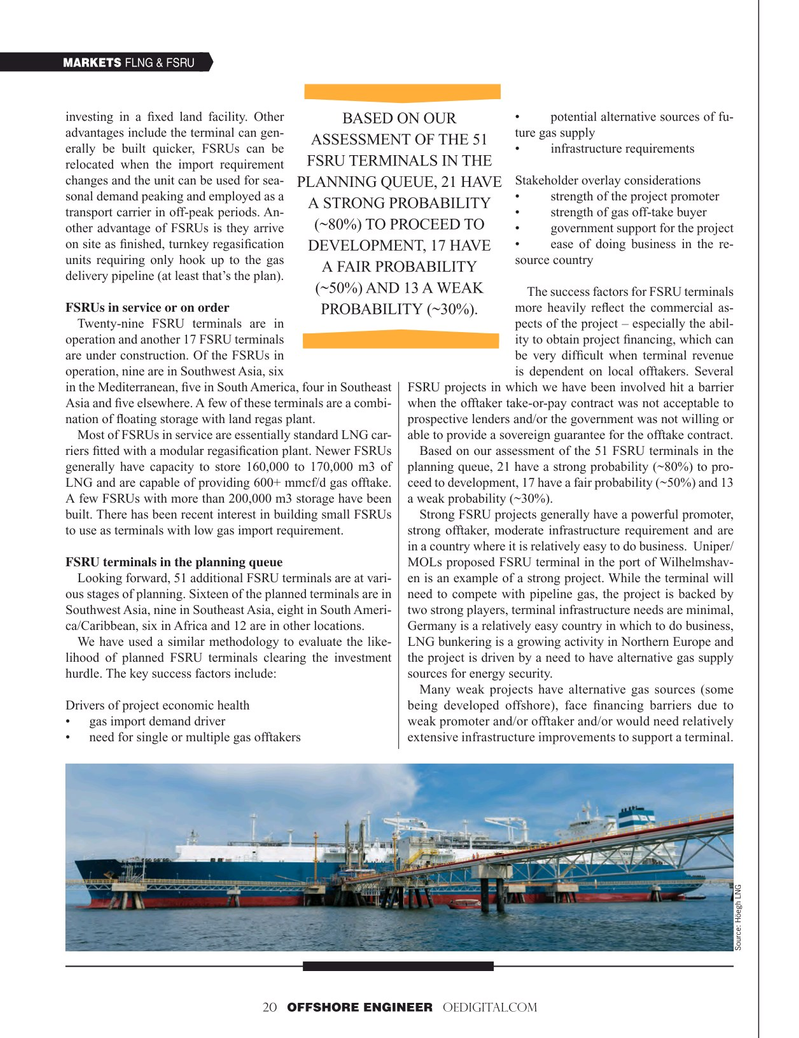
Page 20: of Offshore Engineer Magazine (Jan/Feb 2019)
FPSO/FNLG Outlook and Technologies
Read this page in Pdf, Flash or Html5 edition of Jan/Feb 2019 Offshore Engineer Magazine
MARKETS FLNG & FSRU investing in a ? xed land facility. Other • potential alternative sources of fu-
BASED ON OUR advantages include the terminal can gen- ture gas supply
ASSESSMENT OF THE 51 erally be built quicker, FSRUs can be • infrastructure requirements
FSRU TERMINALS IN THE relocated when the import requirement changes and the unit can be used for sea- Stakeholder overlay considerations
PLANNING QUEUE, 21 HAVE sonal demand peaking and employed as a • strength of the project promoter
A STRONG PROBABILITY transport carrier in off-peak periods. An- • strength of gas off-take buyer (~80%) TO PROCEED TO other advantage of FSRUs is they arrive • government support for the project on site as ? nished, turnkey regasi? cation • ease of doing business in the re-
DEVELOPMENT, 17 HAVE units requiring only hook up to the gas source country
A FAIR PROBABILITY delivery pipeline (at least that’s the plan).
(~50%) AND 13 A WEAK
The success factors for FSRU terminals
FSRUs in service or on order more heavily re? ect the commercial as-
PROBABILITY (~30%).
Twenty-nine FSRU terminals are in pects of the project – especially the abil- operation and another 17 FSRU terminals ity to obtain project ? nancing, which can are under construction. Of the FSRUs in be very dif? cult when terminal revenue operation, nine are in Southwest Asia, six is dependent on local offtakers. Several in the Mediterranean, ? ve in South America, four in Southeast FSRU projects in which we have been involved hit a barrier
Asia and ? ve elsewhere. A few of these terminals are a combi- when the offtaker take-or-pay contract was not acceptable to nation of ? oating storage with land regas plant. prospective lenders and/or the government was not willing or
Most of FSRUs in service are essentially standard LNG car- able to provide a sovereign guarantee for the offtake contract. riers ? tted with a modular regasi? cation plant. Newer FSRUs Based on our assessment of the 51 FSRU terminals in the generally have capacity to store 160,000 to 170,000 m3 of planning queue, 21 have a strong probability (~80%) to pro-
LNG and are capable of providing 600+ mmcf/d gas offtake. ceed to development, 17 have a fair probability (~50%) and 13
A few FSRUs with more than 200,000 m3 storage have been a weak probability (~30%). built. There has been recent interest in building small FSRUs Strong FSRU projects generally have a powerful promoter, to use as terminals with low gas import requirement. strong offtaker, moderate infrastructure requirement and are in a country where it is relatively easy to do business. Uniper/
FSRU terminals in the planning queue MOLs proposed FSRU terminal in the port of Wilhelmshav-
Looking forward, 51 additional FSRU terminals are at vari- en is an example of a strong project. While the terminal will ous stages of planning. Sixteen of the planned terminals are in need to compete with pipeline gas, the project is backed by
Southwest Asia, nine in Southeast Asia, eight in South Ameri- two strong players, terminal infrastructure needs are minimal, ca/Caribbean, six in Africa and 12 are in other locations. Germany is a relatively easy country in which to do business,
We have used a similar methodology to evaluate the like- LNG bunkering is a growing activity in Northern Europe and lihood of planned FSRU terminals clearing the investment the project is driven by a need to have alternative gas supply hurdle. The key success factors include: sources for energy security.
Many weak projects have alternative gas sources (some
Drivers of project economic health being developed offshore), face ? nancing barriers due to • gas import demand driver weak promoter and/or offtaker and/or would need relatively • need for single or multiple gas offtakers extensive infrastructure improvements to support a terminal.
Source: Höegh LNG 20 OFFSHORE ENGINEER OEDIGITAL.COM 18-31 OE 2019.indd 20 18-31 OE 2019.indd 20 1/21/2019 3:07:14 PM1/21/2019 3:07:14 PM

 19
19

 21
21